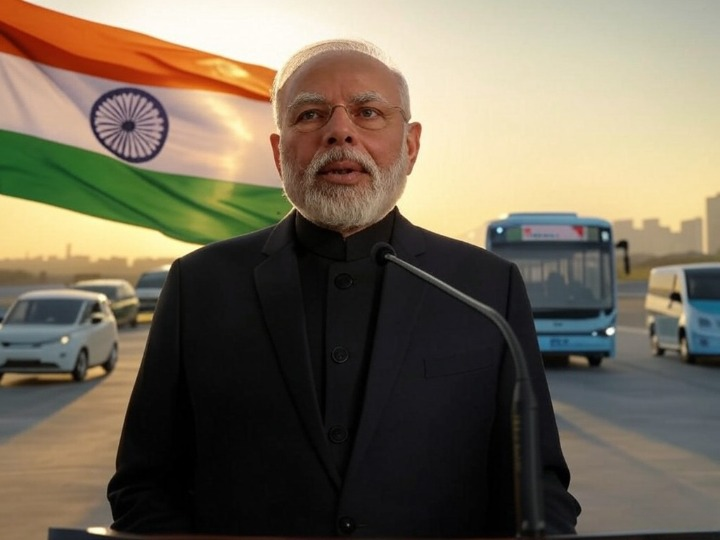India, the world’s third-largest automobile market, is witnessing a rapid transformation with the electric vehicle (EV) industry emerging as one of its fastest-growing segments. Driven by favorable cost dynamics and robust government policies, the sector is poised for significant expansion, with projections indicating a 30% compound annual growth rate (CAGR) in the near future.
1️⃣ Ministry of Heavy Industries (MHI) Schemes for EV Promotion
🔹 PM E-DRIVE Scheme (PM Electric Drive Revolution in Innovative Vehicle Enhancement)
- Launched: 29th September 2024
- Budget: ₹10,900 Cr (2024-2026)
- Objective: Reduce fossil fuel dependence & promote electric mobility
- Covers: e-2W, e-3W, e-Trucks, e-Ambulances, e-Buses
- Includes: Charging infra & vehicle testing upgradation
🔹 Production Linked Incentive (PLI) Scheme for Automobile & Auto Components
- Approved: 15th September 2021
- Budget: ₹25,938 Cr
- Goal: Boost India’s Advanced Automotive Technology (AAT) production
🔹 Production Linked Incentive (PLI) Scheme for Advanced Chemistry Cells (ACC)
- Approved: 12th May 2021
- Budget: ₹18,100 Cr
- Target: Establish 50 GWh battery manufacturing capacity
🔹 FAME-II (Faster Adoption and Manufacturing of Hybrid & Electric Vehicles)
- Implemented: 1st April 2019 (5-year duration)
- Budget: ₹11,500 Cr
- Focus: Domestic EV manufacturing & increasing local value addition
🔹 PM e-Bus Sewa-Payment Security Mechanism (PSM) Scheme
- Launched: 28th October 2024
- Budget: ₹3,435.33 Cr
- Goal: Support 38,000+ e-buses deployment & provide payment security to operators
🔹 Scheme for Promotion of Manufacturing of Electric Passenger Cars in India (SPMEPCI)
- Launched: 15th March 2024
- Investment Requirement: ₹4,150 Cr
- Domestic Value Addition (DVA): 25% (Year 3), 50% (Year 5)
2️⃣ Ministry of Power (MoP) – EV Charging Infrastructure
⚡ EV Charging Guidelines 2024 (17th September 2024)
- Focus: Connected & interoperable EV charging network
- Includes: Battery swapping & charging stations
3️⃣ Ministry of Road Transport & Highways (MoRTH) – EV Adoption Measures
📜 Key Notifications:
✔ Permit Exemption (18th October 2018) – No permit required for battery-operated transport vehicles 🚍
✔ Fee Exemption (2nd August 2021) – No fees for registration or renewal for EVs 📜
✔ All-India Tourist Permit (18th April 2023) – No permit fee for battery-operated tourist vehicles 🚖
✔ Retro-fitment of EV Kits (1st March 2019) – Hybrid/electric conversion standards defined 🔧
✔ EV Registration Plates (7th August 2018) – Yellow-on-Green for transport, White-on-Green for private vehicles 🚗
📢 EV Sales Advisory (12th August 2020) – Allowed sale & registration of e-2Ws without batteries 🔋
4️⃣ EV Infrastructure Expansion – National Highways
🛣 NHAI & National Highways Logistics Management Ltd. (NHLML)
- Mandatory EV Charging Stations at Wayside Amenities (WSAs) 🚏
- Current Status: 50 operational WSAs with charging facilities
- Target: 700 WSAs (90 operational, 458 awarded)
5️⃣ Public Charging Stations (PCS) – FAME-II Scheme
💰 Subsidy: ₹800 Cr (March 2023) to IOCL, BPCL & HPCL for 7,432 PCS ⚡
📊 Installed: 4,523 PCS (as of 01.01.2025), 251 energized 🔋
💰 Additional Funding: ₹73.50 Cr for 980 PCS (March 2024)
🔋 Extra 400 charging stations sanctioned in various states
6️⃣ EV Charging Infrastructure Deployment (State-wise) 🏙
📍 Total Public EV Charging Stations (PCS): 26,367 🚗⚡
🔹 Top States with Maximum EV Charging Stations:
- Karnataka: 5,879 ⚡
- Maharashtra: 3,842 ⚡
- Uttar Pradesh: 2,113 ⚡
- Delhi: 1,951 ⚡
- Tamil Nadu: 1,495 ⚡
- Kerala: 1,288 ⚡
- Rajasthan: 1,285 ⚡
- Gujarat: 1,008 ⚡
🔹 Smallest Networks:
- Ladakh & Lakshadweep: 1 each
- Andaman & Nicobar: 4
📌 Summary
✅ Government pushing multiple schemes for EV adoption & manufacturing 🚀
✅ PLI incentives for battery & auto sector development 🔋
✅ FAME-II boosting local EV production & infrastructure ⚙
✅ Permits & fee waivers for easier EV adoption 🛣
✅ Expanding public charging network with over 26,000 PCS installed 🔌

